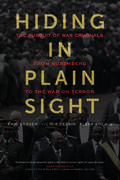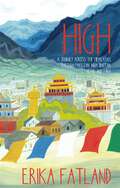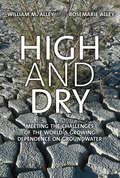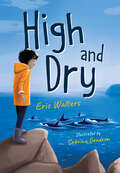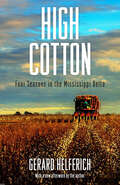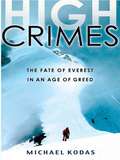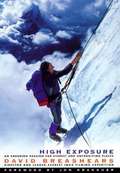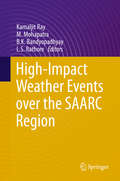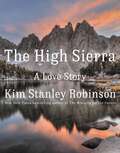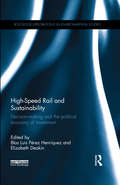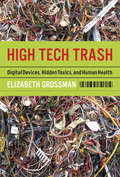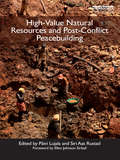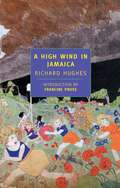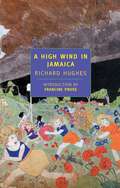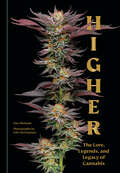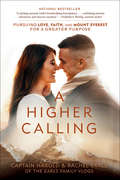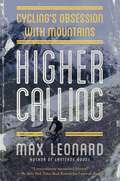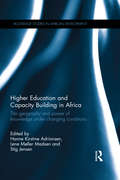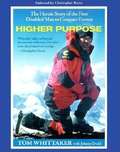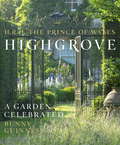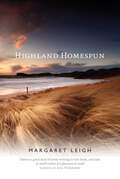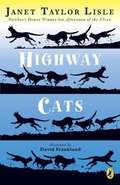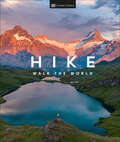- Table View
- List View
Hiding in Plain Sight
by Alexa Koenig Victor Peskin Eric StoverHiding in Plain Sight tells the story of the global effort to apprehend the world's most wanted fugitives. Beginning with the flight of tens of thousands of Nazi war criminals and their collaborators after World War II, then moving on to the question of justice following the recent Balkan wars and the Rwandan genocide, and ending with the establishment of the International Criminal Court and America's pursuit of suspected terrorists in the aftermath of 9/11, the book explores the range of diplomatic and military strategies--both successful and unsuccessful--that states and international courts have adopted to pursue and capture war crimes suspects. It is a story fraught with broken promises, backroom politics, ethical dilemmas, and daring escapades--all in the name of international justice and human rights.Hiding in Plain Sight is a companion book to the public television documentary Dead Reckoning: Postwar Justice from World War II to The War on Terror. For more information about the documentary, visit www.saybrookproductions.com. For information about the Human Rights Center, visit hrc.berkeley.edu.
High: A Journey Across the Himalayas Through Pakistan, India, Bhutan, Nepal and China
by Erika Fatland"Enchanting" Independent"Fatland is a sensitive and insightful chronicler of quotidian lives and a compelling narrator" Observer"Erika Fatland ascends to new heights with her fascinating journey" WanderlustAn ambitious and magnificent new travelogue by internationally bestselling, prizewinning writer Erika Fatland.The Himalayas meander for more than two thousand kilometres through many different countries, from Pakistan to Myanmar via Nepal, India, Tibet and Bhutan, where the world religions of Islam, Buddhism and Hinduism are interspersed with ancient shamanic beliefs. Countless languages and vastly different cultures exist in these isolated mountain valleys. Modernity and tradition collide, while the great powers fight for influence.We have read about climbers and adventurers on their way up Mount Everest, and about travellers on a spiritual quest to remote Buddhist monasteries. Here, however, the focus is on the communities of these Himalayan valleys, those who live and work in this extraordinary region. As Erika Fatland introduces us to the people she meets along her journey, and in particular the women, she takes us on a vivid and dizzying expedition at altitude through incredible landscapes and dramatic, unknown histories. Skilfully weaving together the politics, geography, astrology, theology and ecology of this vast region, she also explores some of the most volatile human conflicts of our times.With her unique gift for listening, and for storytelling, she has become one of the most exciting travel writers of her generation.Translated from the Norwegian by Kari Dickson
High: A Journey Across the Himalayas Through Pakistan, India, Bhutan, Nepal and China
by Erika Fatland"Enchanting" Independent"Fatland distinguishes herself from the stereotypes" Guardian "Fatland is a sensitive and insightful chronicler of quotidian lives and a compelling narrator" Observer"Erika Fatland ascends to new heights with her fascinating journey" Wanderlust"An engaging snapshot of the current residents of this high-altitude battleground . . . Fatland is a lovely writer with a sympathetic eye for the absurd" Financial TimesAn ambitious and magnificent new travelogue by internationally bestselling, prizewinning writer Erika Fatland.The Himalayas meander for more than two thousand kilometres through many different countries, from Pakistan to Myanmar via Nepal, India, Tibet and Bhutan, where the world religions of Islam, Buddhism and Hinduism are interspersed with ancient shamanic beliefs. Countless languages and vastly different cultures exist in these isolated mountain valleys. Modernity and tradition collide, while the great powers fight for influence.We have read about climbers and adventurers on their way up Mount Everest, and about travellers on a spiritual quest to remote Buddhist monasteries. Here, however, the focus is on the communities of these Himalayan valleys, those who live and work in this extraordinary region. As Erika Fatland introduces us to the people she meets along her journey, and in particular the women, she takes us on a vivid and dizzying expedition at altitude through incredible landscapes and dramatic, unknown histories. Skilfully weaving together the politics, geography, astrology, theology and ecology of this vast region, she also explores some of the most volatile human conflicts of our times.With her unique gift for listening, and for storytelling, she has become one of the most exciting travel writers of her generation.Translated from the Norwegian by Kari Dickson
High and Dry: Meeting the Challenges of the World's Growing Dependence on Groundwater
by Rosemarie Alley William M. AlleyAn engaging call to understand and protect groundwater, the primary source of drinking water for almost half of the world's population Groundwater is essential for drinking water and food security. It provides enormous environmental benefits by keeping streams and rivers flowing. But a growing global population, widespread use of industrial chemicals, and climate change threaten this vital resource. Groundwater depletion and contamination has spread from isolated areas to many countries throughout the world. In this accessible and timely book, hydrology expert William M. Alley and science writer Rosemarie Alley sound the call to protect groundwater. Drawing on examples from around the world, including case studies in the United States, Canada, Australia, India, and Sub-Saharan Africa, the authors examine groundwater from key scientific and socioeconomic perspectives. While addressing the serious nature of groundwater problems, the book includes stories of people who are making a difference in protecting this critical resource.
High and Dry (Orca Echoes)
by Eric WaltersDylan lives on a remote island in the Pacific Northwest with his parents, but when they have to go to the mainland, his grandfather weathers a storm to come spend time with him. Grandpa’s brought Dylan a number of gifts, and one comes in handy the next day while they are exploring the coast. In fact, this gift leads the duo to a dangerous discovery: a young orca got stuck on the rocks during the storm. Racing against the sun and the heat, Dylan and Grandpa need to work together to figure out how to save the calf while his pod circles nearby.
High Cotton: Four Seasons in the Mississippi Delta (Banner Books)
by Gerard HelferichThis dirt-under-the-fingernails portrait of a small-time farmer follows Zack Killebrew over a single year as he struggles to defend his cotton against such timeless adversaries as weeds, insects, and drought, as well as such twenty-first-century threats as globalization. Over the course of the season, Helferich describes how this singular crop has stamped American history and culture like no other. Then, as Killebrew prepares to harvest his cotton, two hurricanes named Katrina and Rita devastate the Gulf Coast and barrel inland. Killebrew's tale is at once a glimpse into our nation's past, a rich commentary on our present, and a plain-sighted vision of the future of farming in the Mississippi Delta.On first publication, High Cotton won the Authors Award from the Mississippi Library Association. This updated edition includes a new afterword, which resumes the story of Zack Killebrew and his family, discusses how cotton farming has continued to change, and shows how the Delta has retained its elemental character.
High Crimes: The Fate of Everest in an Age of Greed
by Michael KodasHigh Crimes is journalist Michael Kodas's gripping account of life on top of the world--where man is every bit as deadly as Mother Nature. In the years following the publication of Into Thin Air, much has changed on Mount Everest. Among all the books documenting the glorious adventures in mountains around the world, none details how the recent infusion of wealthy climbers is drawing crime to the highest place on the planet. The change is caused both by a tremendous boom in traffic, and a new class of parasitic and predatory adventurer. It's likely that Jon Krakauer would not recognize the camps that he visited on Mount Everest almost a decade ago. This book takes readers on a harrowing tour of the criminal underworld on the slopes of the world's most majestic mountain. High Crimes describes two major expeditions: the tragic story of Nils Antezana, a climber who died on Everest after he was abandoned by his guide; as well as the author's own story of his participation in the Connecticut Everest Expedition, guided by George Dijmarescu and his wife and climbing partner, Lhakpa Sherpa. Dijmarescu, who at first seemed well-intentioned and charming, turned increasingly hostile to his own wife, as well as to the author and the other women on the team. By the end of the expedition, the three women could not travel unaccompanied in base camp due to the threat of violence. Those that tried to stand against the violence and theft found that the worst of the intimidation had followed them home to Connecticut. Beatings, thefts, drugs, prostitution, coercion, threats, and abandonment on the highest slopes of Everest and other mountains have become the rule rather than the exception. Kodas describes many such experiences, and explores the larger issues these stories raise with thriller-like intensity.
High Exposure: An Enduring Passion for Everest and Unforgiving Places
by David F. Breashears Jon KrakauerFor generations of resolute adventurers, from George Mallory to Sir Edmund Hillary, Tenzing Norgay to Jon Krakauer, Mount Everest and the world's greatest peaks have provided the ultimate testing ground. As the world's fascination with mountaineering reaches a fever pitch, the question remains: Why climb? In High Exposure, elite mountaineer and acclaimed filmmaker David Breashears answers with an intimate and captivating look at his life. Breashears's passion for climbing began on the cliffs of Boulder, Colorado--and nearly ended on the south side of Everest in 1996.
High-Impact Weather Events over the SAARC Region
by Kamaljit Ray M. Mohapatra B. K. Bandyopadhyay L. S. RathoreThis book is a compilation of papers contributed by researchers and scientists from SAARC nations and deals with high-impact weather conditions, their prediction and potential consequences for populations in the SAARC region. There have been a number of recent advances in our understanding and prediction of cyclones, severe thunderstorms, squalls, heat and cold waves, droughts and heavy rainfall, based on the latest observational data and NWP modeling platform. The SAARC region is vulnerable to high-impact weather events because of geophysical features like high mountains, plateaus and vast oceans. As our climate continues to change over the coming years, the likelihood of extreme and potentially high-impact weather and climate events will be at its highest when natural and anthropogenic effects combine. All chapters were written by leading experts in their respective research and operational fields. The book reviews the latest research, future needs, forecasting skills and societal impacts of extreme weather events and offers high-quality reference material for weather forecasters, disaster managers and researchers.
The High-Mountain Cryosphere
by Huggel, Christian and Carey, Mark and Clague, John J. and Kääb, Andreas Christian Huggel Mark Carey John J. Clague Andreas KääbThis edited volume, showcasing cutting-edge research, addresses two primary questions - what are the main drivers of change in high-mountains and what are the risks implied by these changes? From a physical perspective, it examines the complex interplay between climate and the high-mountain cryosphere, with further chapters covering tectonics, volcano-ice interactions, hydrology, slope stability, erosion, ecosystems, and glacier- and snow-related hazards. Societal dimensions, both global and local, of high-mountain cryospheric change are also explored. The book offers unique perspectives on high-mountain cultures, livelihoods, governance and natural resources management, focusing on how global change influences societies and how people respond to climate-induced cryospheric changes. An invaluable reference for researchers and professionals in cryospheric science, geomorphology, climatology, environmental studies and human geography, this volume will also be of interest to practitioners working in global change and risk, including NGOs and policy advisors.
The High Sierra: A Love Story
by Kim Stanley RobinsonA &“sublime&” and &“radically original&” exploration of the Sierra Nevadas, the best mountains on Earth for hiking and camping, from New York Times bestselling novelist Kim Stanley Robinson (Bill McKibben, Gary Snyder). Kim Stanley Robinson first ventured into the Sierra Nevada mountains during the summer of 1973. He returned from that encounter a changed man, awed by a landscape that made him feel as if he were simultaneously strolling through an art museum and scrambling on a jungle gym like an energized child. He has returned to the mountains throughout his life—more than a hundred trips—and has gathered a vast store of knowledge about them. The High Sierra is his lavish celebration of this exceptional place and an exploration of what makes this span of mountains one of the most compelling places on Earth.Over the course of a vivid and dramatic narrative, Robinson describes the geological forces that shaped the Sierras and the history of its exploration, going back to the indigenous peoples who made it home and whose traces can still be found today. He celebrates the people whose ideas and actions protected the High Sierra for future generations. He describes uniquely beautiful hikes and the trails to be avoided. Robinson&’s own life-altering events, defining relationships, and unforgettable adventures form the narrative&’s spine. And he illuminates the human communion with the wild and with the sublime, including the personal growth that only seems to come from time spent outdoors.The High Sierra is a gorgeous, absorbing immersion in a place, born out of a desire to understand and share one of the greatest rapture-inducing experiences our planet offers. Packed with maps, gear advice, more than 100 breathtaking photos, and much more, it will inspire veteran hikers, casual walkers, and travel readers to prepare for a magnificent adventure.
High-Speed Rail and Sustainability: Decision-making and the political economy of investment (Routledge Explorations in Environmental Studies)
by Blas Luis Pérez Henríquez Elizabeth DeakinHigh speed rail (HSR) is being touted as a strategic investment for connecting people across regions, while also fostering prosperity and smart urban growth. However, as its popularity increases, its implementation has become contentious with various parties contesting the validity of socioeconomic and environmental objectives put forward as justification for investment. High Speed Rail and Sustainability explores the environmental, economic and social effects of developing a HSR system, presenting new evaluations of the proposed system in California in the US as well as lessons from international experience. Drawing upon the accumulated experience from past HSR system development around the world, leading experts present a diverse set of perspectives as well as diverse contexts of implementation. Assessments of the California case as well as cases from Japan, France, Germany, Italy, Spain, Taiwan, China, and the UK show how governments and stakeholders have bridged the gap between the vision and the realities of connecting metropolitan regions through HSR. This is a valuable resource for academics, researchers and policy-makers in the areas of urban planning, civil engineering, transportation and environmental design.
High Tech Trash: Digital Devices, Hidden Toxics, and Human Health
by Elizabeth GrossmanThe Digital Age was expected to usher in an era of clean production, an alternative to smokestack industries and their pollutants. But as environmental journalist Elizabeth Grossman reveals in this penetrating analysis of high tech manufacture and disposal, digital may be sleek, but it's anything but clean. Deep within every electronic device lie toxic materials that make up the bits and bytes, a complex thicket of lead, mercury, cadmium, plastics, and a host of other often harmful ingredients.High Tech Trash is a wake-up call to the importance of the e-waste issue and the health hazards involved. Americans alone own more than two billion pieces of high tech electronics and discard five to seven million tons each year. As a result, electronic waste already makes up more than two-thirds of the heavy metals and 40 percent of the lead found in our landfills. But the problem goes far beyond American shores, most tragically to the cities in China and India where shiploads of discarded electronics arrive daily. There, they are "recycled"-picked apart by hand, exposing thousands of workers and community residents to toxics.As Grossman notes, "This is a story in which we all play a part, whether we know it or not. If you sit at a desk in an office, talk to friends on your cell phone, watch television, listen to music on headphones, are a child in Guangdong, or a native of the Arctic, you are part of this story."The answers lie in changing how we design, manufacture, and dispose of high tech electronics. Europe has led the way in regulating materials used in electronic devices and in e-waste recycling. But in the United States many have yet to recognize the persistent human health and environmental effects of the toxics in high tech devices. If Silent Spring brought national attention to the dangers of DDT and other pesticides, High Tech Trash could do the same for a new generation of technology's products.
High-Value Natural Resources and Post-Conflict Peacebuilding (Post-Conflict Peacebuilding and Natural Resource Management)
by Päivi Lujala Siri Aas RustadFor most post-conflict countries, the transition to peace is daunting. In countries with high-value natural resources – including oil, gas, diamonds, other minerals, and timber –the stakes are unusually high and peacebuilding is especially challenging. Resource-rich post-conflict countries face both unique problems and opportunities. They enter peacebuilding with an advantage that distinguishes them from other war-torn societies: access to natural resources that can yield substantial revenues for alleviating poverty, compensating victims, creating jobs, and rebuilding the country and the economy. Evidence shows, however, that this opportunity is often wasted. Resource-rich countries do not have a better record in sustaining peace. In fact, resource-related conflicts are more likely to relapse. Focusing on the relationship between high-value natural resources and peacebuilding in post-conflict settings, this book identifies opportunities and strategies for converting resource revenues to a peaceful future. Its thirty chapters draw on the experiences of forty-one researchers and practitioners – as well as the broader literature – and cover a range of key issues, including resource extraction, revenue sharing and allocation, and institution building. The book provides a concise theoretical and practical framework that policy makers, researchers, practitioners, and students can use to understand and address the complex interplay between the management of high-value resources and peace. High-Value Natural Resources and Post-Conflict Peacebuilding is part of a global initiative led by the Environmental Law Institute (ELI), the United Nations Environment Programme (UNEP), the University of Tokyo, and McGill University to identify and analyze lessons in natural resource management and post-conflict peacebuilding. The project has generated six edited books of case studies and analyses, with contributions from practitioners, policy makers, and researchers. Other books in the series address land; water; livelihoods; assessing and restoring natural resources; and governance.
A High Wind in Jamaica
by Richard HughesRichard Hughes's celebrated short novel is a masterpiece of concentrated narrative. Its dreamlike action begins among the decayed plantation houses and overwhelming natural abundance of late nineteenth-century Jamaica, before moving out onto the high seas, as Hughes tells the story of a group of children thrown upon the mercy of a crew of down-at-the-heel pirates. A tale of seduction and betrayal, of accommodation and manipulation, of weird humor and unforeseen violence, this classic of twentieth-century literature is above all an extraordinary reckoning with the secret reasons and otherworldly realities of childhood.
A High Wind in Jamaica
by Francine Prose Richard HughesRichard Hughes's celebrated short novel is a masterpiece of concentrated narrative. Its dreamlike action begins among the decayed plantation houses and overwhelming natural abundance of late nineteenth-century Jamaica, before moving out onto the high seas, as Hughes tells the story of a group of children thrown upon the mercy of a crew of down-at-the-heel pirates. A tale of seduction and betrayal, of accommodation and manipulation, of weird humor and unforeseen violence, this classic of twentieth-century literature is above all an extraordinary reckoning with the secret reasons and otherworldly realities of childhood.
Higher: The Lore, Legends, and Legacy of Cannabis
by Dan MichaelsA mind-blowing visual journey through the legends, legacy, and lore of marijuana, including fun facts, engrossing stories, and 100 mouthwatering portraits of the most popular strains out there.Higher breaks through the cloud of confusion around marijuana with a clear, concise, and comprehensive breakdown of bud. The culmination of significant research and conversation within the cannabis community, Higher offers portraits of the 100 most popular strains of yesterday and today, including intel on lineage, taste, THC content, and common effects, as well as stories about the misfits, visionaries, hijinks, and happenings that make cannabis so entertaining. Topics include: Origin Stories: The rise and spread of modern cannabis, from its emergence in the Hippie Trail of Central Asia up to the present-day Emerald Triangle in California.Prohibition: A historical timeline from legal to illegal and back to legal, including the &“Marihuana Tax Act,&” the war on drugs, medical marijuana, and the end of prohibition.Anatomy: A complete breakdown of the plant&’s unique and complex botany.Breeding: The evolution of cannabis, from &“wild&” landraces and the first domesticated crops to the invention of sinsemilla and hydroponic hybrids.Consumption: All the ways humans have imbibed through the ages—eating, smoking, rolling, vaping, tinctures, and so much more.Strains: The world&’s most important and influential cannabis strains ever created, including profiles of fifty classic and fifty modern strains.Featuring stunning, whole-plant photography, Higher offers the eye candy and sound information today&’s diverse and discerning cannabis enthusiast wants.
A Higher Calling: Pursuing Love, Faith, and Mount Everest for a Greater Purpose
by Harold Earls Rachel EarlsThe husband and wife behind the popular Earls Family Vlogs share their inspiring love story of how an expedition to climb Mount Everest deepened their faith, strengthened their commitment, and sharpened their vision to make a difference in the world. As a senior at West Point, Harold Earls dreamed of summiting Mount Everest after graduation and bringing awareness to the issue of PTSD in soldiers and veterans. But as a novice mountain climber and newlywed, could he really leave his wife, Rachel, on the other side of the world to pursue such a dangerous quest? After all, Rachel&’s dream was to be a wife and mother. She knew that her husband&’s audacious goal might lead to her to give up everything. A Higher Calling takes us on a beautiful journey through the ups and downs of their relationship, from their unlikely introduction and whirlwind romance to their fairy-tale wedding and the dreams they shared. Dreams that required tremendous sacrifice and faith—in each other and in God. As their dreams are realized, witness how Harold and Rachel used their powerful bond of love to overcome obstacles and learn that life is about doing versus having, serving versus getting, being versus wanting. A Higher Calling shows each of us that when God&’s purpose and our passion meet, we can transcend any sacrifice we make on the mountains of adversity. And as we approach life with an attitude of thanksgiving, we realize that being joyful and living in love is worth it. Every time.
Higher Calling: Cycling's Obsession With Mountains
by Max LeonardGuaranteed to appeal to all lovers of cycling, the author of Lanterne Rouge explores the glorious—and painful—allure of cycling up mountain peaks. Written with verve and enthusiasm, A Higher Calling explores why mountains have such a magnetic appeal to cyclists the world over. But Max Leonard, himself an accomplished amateur cyclist, does not forget the pain, the glory, the sweat, and the tears that go into these grueling climbs. After all, cycling up a mountain is hard. So hard that, to many, it can seem absurd. But for others, climbing a mountain gracefully (and beating your competitors up the slope) represents the pinnacle of cycling achievement. It is where legends are forged. Many books tell you where the mountains are, or how long and how high. None of them ask why. Why are mountain ranges professional cycling’s Coliseum? Why do amateurs also make pilgrimages to these high, remote roads? Why are the roads even there in the first place to lure us on to these obsession inducing climbs? Just why are mountains so enthralling? “This is real cycling, where the glory is and where dreams come true,” according to Bradley Wiggins. Mountains are where cycling's greatest heroes have made their names. Every amateur rider wishes they could climb better, too. Are all these people addicted to the pain? To the achievement? Or to the allure of the peaks? Some spend their weekends and holidays cycling up mountains from start to finish. But how does a rider push themselves beyond their limits to get up a 10% gradient on pedal power alone? What is happening when they do? A Higher Calling explores the central place of mountains in the folklore of road cycling. Blending adventure and travel writing with the rich narrative of racing, Max Leonard takes the reader from the battles that created the Alpine roads to the shepherds tending their flocks on the peaks, and to a Grand Tour climax on the “highest road in Europe.” And he tells stories of courage and sacrifice, war and love, obsession and even elephants, along the way.
Higher Education and Capacity Building in Africa: The geography and power of knowledge under changing conditions (Routledge Studies in African Development)
by Hanne Kirstine Adriansen Lene Møller Madsen Stig JensenHigher education has recently been recognized as a key driver for societal growth in the Global South and capacity building of African universities is now widely included in donor policies. The question is; how do capacity building projects affect African universities, researchers and students? Universities and their scientific knowledges are often seen to have universal qualities; therefore, capacity building may appear straight forward. Higher Education and Capacity Building in Africa contests such universalistic notions. Inspired by ideas about the ‘geography of scientific knowledge’ it explores what role specific places and relationships have in knowledge production, and analyses how cultural experiences are included and excluded in teaching and research. Thus, the different chapters show how what constitutes legitimate scientific knowledge is negotiated and contested. In doing so, the chapters draw on discussions about the hegemony of Western thought in education and knowledge production. The authors’ own experiences with higher education capacity building and knowledge production are discussed and used to contribute to the reflexive turn and rise of auto-ethnography. This book is a valuable resource for researchers and postgraduate students in education, development studies, African studies and human geography, as well as anthropology and history.
Higher Purpose: Heroic Story of the First Disabled Man to Conquer Everest
by Tom Whittaker Johnny DoddAs Tom Whittaker struggled to keep conscious the night of 27 November 1979, his thoughts focused on a singular plea: Please, don't let them take my legs. Earlier that evening, a drunk driver struck Tom's VW van on an isolated, snow-covered road in Idaho and shattered his legs -- and his dreams. When he awoke from emergency surgery, the 31-year-old mountaineer's right leg had been amputated at mid-shin and his right kneecap removed. Devastated, he pondered suicide. Finally it occurred to him: you don't need your lower leg to kayak. Seven months after the accident, Tom hobbled down to the south fork of the Payette River, and began paddling. In the years since then, Tom has not only taken his life back, he's taken his family, his fellow sportsmen, and hundreds of thousands of disabled and able-bodied people to the top of the world. In May 1998, Tom became the first amputee to summit Mount Everest. The climb and his inspirational story, as well as his work on behalf of disabled people around the world, have earned him the recognition as one of America's most courageous heroes.
Highgrove: A Garden Celebrated
by HRH The Prince of Wales Bunny GuinnessHIGHGROVE: A GARDEN CELEBRATED is a commemoration of the beautiful, mature gardens planned and planted by The Prince of Wales over thirty years ago. The gardens at Highgrove evoke intense emotion. In January, the dramatic light and early snowdrops of the Stumpery are exquisite; the glistening emerald lawns and tree blossoms in Spring lift the spirits with a promise of what is to come; in Summer, the longed-for delphiniums in the Sundial Garden stand proudly to attention and dramatic leaf colours welcome Autumn to the Arboretum as the harvesting in the Kitchen Garden begins. In Winter the structural elements of the garden have their moment of glory as the year comes to a close and the cycle of the seasons continues.Lavishly illustrated with photographs that capture both the light and detail of this magisterial space, this beautiful book will delight and inspire gardeners of every level. It is an exquisite celebration of garden design, passion and inspiration.
Highland Homespun
by Margaret LeighIn the beloved Scottish author&’s classic memoir, she recounts a year in the life of a small traditional farm in the Western Highlands. In 1933, Margaret Leigh took over the tenancy of Achnabo farm, in a beautiful corner of the West Highlands overlooking the isle of Skye. In this unsentimental yet exquisitely written book, she recounts a year of farming life there, from the burning of the land and ploughing in March, through planting and sowing in April to haymaking and harvesting in September. Rich in the details of day-to-day life—such as a visit to the smithy, the arrival of some new bulls, and the annual journey of the cows to the summer shielings—Highland Homespun provide fascinating insights into the farming life in the north of Scotland before the arrival of hydro-electric power. Local characters and customs add another rich dimension to this reflective and poignant memoir of a world now vanished.
Highway Cats
by Janet Taylor LisleWhen three kittens are thrown off the back of a truck, none of the highway cats knows what to make of them. They seem to have an appeal?an energy, even?that Khalia Koo, Jolly Roger, and the rest of the mangy, feral cats don?t understand. But there are bigger issues to figure out when the bulldozers start coming, threatening to demolish their homes as well as several historical landmarks. Can three little kittens be the answer to saving the town? .
Hike: Adventures on Foot
by DK EyewitnessIt&’s hard to beat the satisfaction of traveling on foot – settling into a steady rhythm, surrounded by incredible scenery, with the freedom to stop wherever takes your fancy. This endlessly rewarding – and sustainable – activity is joyously celebrated in Hike, which reveals 125 of the most scenic and spectacular walking trails across the globe. It&’s the ultimate inspiration for exploring under your own steam: ramble along coastal paths in Europe, scale soaring mountain peaks in Africa and trek through amber-hued canyons in North America.Compiled by a team of outdoor enthusiasts, this book is packed with ideas for your next hiking trip. Awe-inspiring images and compelling descriptions of each trail will have you itching to get walking, while handy maps, elevation profiles, and practical information – including things like distance and total elevation gain – will help you plan the nitty-gritty of your trip. We&’ve also included the best places to explore en route – whether that&’s lunch spots, epic viewpoints, or nearby must-see sights – as well as suggestions for alternative ways to tackle a trail. Hike is your ticket to the adventure of a lifetime. Inside Hike, you will find: - Practical top tips for getting the most out of each hike - including recommended stops, viewpoints en route, and how to make the hike shorter/longer depending on how much time you have.- Organized Chapters: Hikes are arranged within each chapter geographically, and include the distance and total ascent to help readers to find a suitable route.- Includes maps and elevation profiles - Covers 125 hikes, from straightforward day, walks to epic cross-country treks- A carefully curated selection of rides, chosen by hiking and travel experts - Each chapter covers a different continent (North America, Central, and South America, Europe, Africa, and the Middle East, Asia, Australasia)About DK Eyewitness:At DK Eyewitness, we believe in the power of discovery. We make it easy for you to explore your dream destinations. DK Eyewitness travel guides have been helping travelers to make the most of their breaks since 1993. DK Eyewitness travel guides have been helping travelers to make the most of their breaks since 1993. Filled with expert advice, striking photography and detailed illustrations, our highly visual DK Eyewitness guides will get you closer to your next adventure. We publish guides to more than 200 destinations, from pocket-sized city guides to comprehensive country guides. Named Top Guidebook Series at the 2020 Wanderlust Reader Travel Awards, we know that wherever you go next, your DK Eyewitness travel guides are the perfect companion
